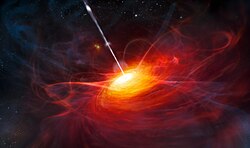| Event type | Gamma-ray burst, supernova |
|---|---|
| SNSLSN | |
| Duration | at least 7 hours |
| Constellation | Phoenix |
| Right ascension | 00h 57m 22.63s |
| Declination | −46° 48′ 03.8″ |
| Other designations | GRB 111209A, SN 2011kl |
| | |
GRB 111209A is the second longest lasting gamma-ray burst (GRB) detected by the Swift Gamma-Ray Burst Mission, observed on December 9, 2011. [1] Its duration is longer than 7 hours, implying this event has a different kind of progenitor than normal long GRBs. It was first proposed that the progenitor of this event was a blue supergiant star with low metallicity. Later, it was also proposed that this event is the prototype of a new class of GRBs, ultra-long GRBs.
The GRB was associated with the magnetar-powered supernova 2011kl, an object of intermediate luminosity between conventional GRB supernovae and superluminous supernovae. [2]


